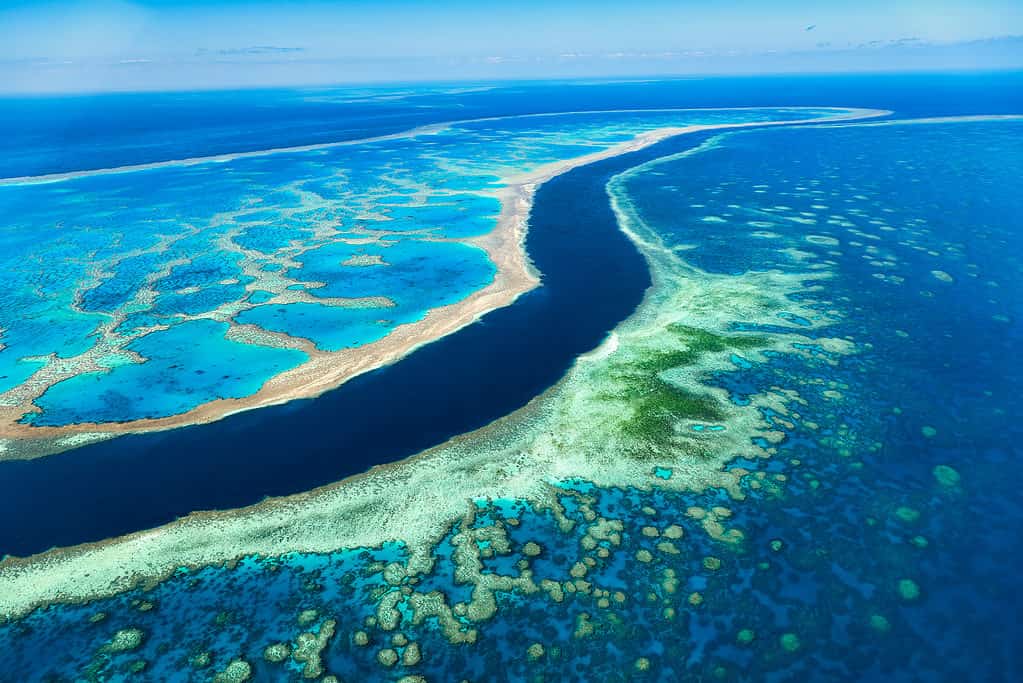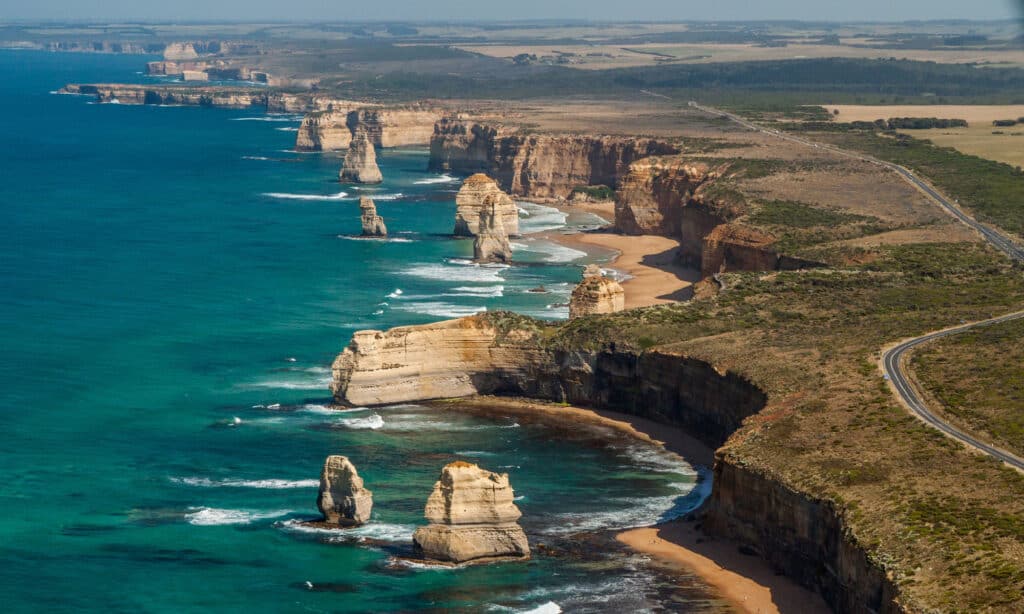Australia is a nation of striking contrasts, stunning landscapes, and a diverse mix of cultures. The sixth largest country globally by land area, it’s the only one to claim an entire continent all its own. Four states form its pillars: New South Wales, Victoria, Queensland, and Western Australia. They are also the country’s most populous states. These powerhouses not only encapsulate Australia’s rich past but also symbolize its dynamic present and uncertain future. Here, we dive into the genesis of these states, the challenges and opportunities shaping their present, and explore what the future may hold for them. While almost certain to remain the four largest and most important states come 2050 and beyond, they will need to skillfully navigate a slew of unprecedented changes to continue to thrive.

Fire making by Aboriginal Australians highlights the contrasting relationships to fire between cultures and displays a form of “Aboriginalism.”
©ChameleonsEye/Shutterstock.com
The Making of Australia’s Largest States
Australia’s geopolitical landscape has evolved remarkably since its founding as a British colony in 1788 to its statehood in 1901. This evolution was shaped by colonial divisions, geography, demographics, and immigration policies. In this section, we’ll explore how distinct states have emerged, examining their unique characteristics and challenges.
New South Wales: The Mother Colony
New South Wales, initially encompassing even parts of New Zealand, was the foundation upon which modern Australia was built. Over time, this expansive colony was divided to form other states such as Tasmania, Victoria, Queensland, and South Australia, each with its unique attributes and challenges.
Victoria: The Manufacturing Hub
Victoria, once a part of New South Wales, has carved out an identity for itself with its fertile lands and bustling manufacturing sector. Despite its small size, it has a dense population, a legacy of its rich natural resources and industrial opportunities.
Queensland: The Sunshine State
Queensland, another offshoot of New South Wales, stands out for its tropical climate and diverse ecosystems. It is known for both its natural beauty, including the Great Barrier Reef, and its agricultural contributions.
Western Australia: The Independent Origin
Unlike the states that emerged from New South Wales, Western Australia originated independently in 1829. Known for its arid landscapes, it is sparsely populated and rich in mineral resources, contrasting sharply with its eastern counterparts.
The Role of Immigration
Australia’s demographic diversity is largely due to waves of immigration, from early British settlers to recent arrivals from Asia and Africa. Past immigration policies, like the now-repealed White Australia Policy, have played a significant role in shaping the nation’s multi-ethnic fabric.
Noteworthy Historical Moments
- The Eureka Stockade of 1854 was pivotal for Australian democracy, while the 1932 opening of the Sydney Harbour Bridge, the world’s largest steel arch bridge until 2012, provided a much-needed employment boost.
- South Australia led the way in democratic rights for women as early as 1894.
- Tasmania’s dark history includes being the last state to abolish capital punishment in 1968.
- The Northern Territory’s quest for statehood remains tied to Indigenous rights, and Western Australia’s failed 1933 secession bid offers a window into regional identities.
- Queensland’s Great Barrier Reef is the world’s largest coral reef system and a UNESCO World Heritage Site as of 1981. In addition to being a natural wonder, it’s also a barometer of climate change due to its sensitivity to environmental shifts.

The world’s largest system of coral reefs, the Great Barrier Reef in Queensland, is highly sensitive to environmental shifts.
©iStock.com/Cavan Images
Criteria for Ranking: A Multi-faceted Approach
In evaluating the four Australian states, we rely on three key metrics: land area, population, and economic diversity. Land area highlights not just the size but also the range of natural resources and environmental challenges. Population serves as an indicator of human capital and market potential. Lastly, economic diversity reflects the resilience and adaptability of a state’s economy, moving beyond the narrow focus on Gross Domestic Product (GDP).
Size and Population
Being a part of the world’s sixth-largest country by land area gives these states access to valuable resources such as coal and iron ore. However, it also saddles them with environmental responsibilities like preserving the Great Barrier Reef and managing bushfire risks. Therefore, land area is a nuanced metric for evaluation.
Australia’s 2020 population of around 25.7 million, concentrated mostly in coastal cities, places pressure on urban planning and infrastructure. It also offers a limited domestic market, making each state reliant on trade and immigration to strengthen its workforce and consumer base. Various bodies project the Land Down Under to be home to anywhere between roughly 31 to 42.5 million people by 2050.
Economy
While Australia’s high per capita GDP of around $94, 717 AUD ($60,798 USD) in 2022 suggests economic strength, its moderate growth rate reveals vulnerabilities to external factors such as trade tensions and health crises. Recent years the Land Down Under has grown its economy at an annual average of 2.4 percent. The individual states within the country, however, exhibit economic diversity. With sectors ranging from mining to tourism, this makes them variously resilient to global shifts.
Our ranking employs a balanced weighting of these three metrics, with economic diversity, rather than GDP, emphasized. This approach offers a more comprehensive understanding of each state’s capacity to adapt to challenges, particularly relevant for Australia, where economic, environmental, and social aspects often intersect.
Spotlight on Australia’s Largest States
Australia is a land of geographic and demographic contrasts, captured vividly in its four major states: New South Wales (NSW), Victoria, Queensland, and Western Australia. Together, these states are home to over 90 percent of the country’s population, each offering a unique blend of opportunities and challenges.
New South Wales (NSW)
As Australia’s most populous state, NSW has more than 8.15 million residents as of 2021. Sydney, its vibrant capital, serves as a global financial hub and an emerging tech center, often referred to as “Silicon Beach.” Sydney’s landmarks, like the Opera House and Bondi Beach, are iconic. However, perhaps a victim of its own success, the state faces hurdles such as water management and housing affordability.
Victoria
Also often referred to by its postal code “VIC” and known for its cultural richness, this state’s population exceeds 6.7 million. Melbourne, its capital, stands out as a haven for arts, theater, and music. Despite its small land area, Victoria’s high population density requires creative solutions for environmental sustainability and pandemic resilience.
Queensland
Home to over 5.2 million people, Queensland is a tropical paradise known for its natural beauty. Brisbane, its laid-back capital, is celebrated for its riverfront lifestyle. The state is also a significant agricultural hub, producing sugarcane and tropical fruits. But it faces challenges in healthcare and regional growth.
Western Australia
With a population of over 2.7 million, Western Australia is vast and abundant in resources. Its capital, Perth, is equally famous for its sunny climate, being a gateway to Asia and Europe. While mineral and gas exports anchor its economy, Western Australia struggles to focus on managing its remote communities and diversifying its economic base.
Each of these states have their unique strengths and confront their specific challenges. Further, they are shaped by their own legislative landscape. This localized governance model allows for tailored strategies to tackle a range of issues, from environmental concerns to economic diversification.

In Sydney, New South Wales’ capital, the giraffes at the Taronga Zoo get a great view of the famous Sydney Opera House.
©FiledIMAGE/Shutterstock.com
The Evolving World of Work in Australia
Australia stands at a transformative crossroads in its labor market, shaped by the forces of automation, climate change, and the rise of future-resistant occupations. Here, we dissect these driving elements and outline key policy directions for a robust job landscape.
The Automation and AI Impact
By 2030, nearly half of Australia’s work activities could be automated, affecting an estimated 3.5 million workers, according to a McKinsey & Company report. Queensland and Western Australia may see higher rates of automation, particularly in mining and agriculture. On the flip side, Victoria and New South Wales could benefit from a surge in high-skill services. Interestingly, automation could also create new job roles, much like the internet gave birth to social media marketing and app development.
Climate Change: A Game-Changer
Climate change poses a dual threat and opportunity for traditional sectors like agriculture, manufacturing, and tourism. Such sectors contribute around 40 percent to the national GDP. While challenges like extreme weather and scarce water resources loom large, the crisis could stimulate “green jobs” in renewable energy and sustainable agriculture.
Building Resilient Occupations
Industries such as healthcare and education are both expanding and resistant to technological or environmental disruptions, thanks to the indispensable human element. They are in effect “future proof.” The gig economy and remote work offer new layers of flexibility but raise questions around job security and benefits.
Industry Highlights
Healthcare
Projected to grow from 8 to 15 percent of GDP in the next 40 years, driven by an aging population and evolving healthcare technologies.
Education
Set to expand due to a growing demand for continuous learning and a drive to increase its contribution to global research. Australia envisions itself in the top 10 countries for education and research by 2040. Currently, it ranks number 25.
Professional Services
Likely to grow, with a focus on emerging areas like AI, cybersecurity, and biotechnology.
Arts and Recreation
Expected to skyrocket, fueled by increasing cultural and leisure activities, especially sports.

Nearly 15 percent of the remaining koala population perished in the late 2019 bush fires.
©Andrea Izzotti/Shutterstock.com
Climate Change and its Human Ripple Effects in Australia
Climate change, more than a mere environmental concern, has fast become a complex, multi-faceted issue that reverberates through every society it touches. Australia, a land of vast terrains and ecosystems, is experiencing firsthand the impacts of a shifting climate. According to data from the Australian Museum and CSIRO and the Bureau of Meteorology, the country has seen a temperature rise of approximately 1.44 ± 0.24 degrees Celsius since record keeping began in 1910. The calamitous bushfires, recurring droughts, and damaging floods aren’t mere outliers—they’re harbingers of an unsettling, climate-altered future.
New South Wales: The Mother Colony Under Environmental Siege
Originally the founding colony, New South Wales splintered to form states like Tasmania and Victoria. Today, regions like central and western New South Wales wrestle with escalating drought conditions, fueling increasingly destructive bushfires. Additionally, the state suffered from the March 2021 floods, affecting over 40,000 people.
Victoria: A Complex Landscape Undergoing Radical Change
Once a hub of manufacturing and industry, Victoria’s climate vulnerabilities were laid bare by the 2009 Black Saturday fires. The state is also facing threats from rising sea levels, which contribute to coastal erosion and increase the frequency of storm surges.
Queensland: Paradise at Risk
Queensland’s lush biodiversity is at risk. Not only from escalating bushfires, but also from extreme rainfall. Significantly, the March 2021 floods inundated large parts of the state.
South Australia: The Dry and The Wet
Although a distinct state economically and culturally, South Australia isn’t immune to the climate-induced extremes affecting its peers. The state’s unique balance is becoming increasingly precarious due to changing weather patterns.
Coastal Challenges: The Encroaching Seas
A 25 centimeter (nearly 10 inches) rise in sea levels since 1880 endangers coastal communities across all these states.
Human Tolls and Responses: From Bushfires to Climate Migration
Both the Black Saturday fires of 2009 and the Black Summer of 2019-2020 have been devastating, affecting human lives and natural habitats. Complicating this are the emerging trends of climate-driven internal and external migration. Indeed, the United Nations estimates that global environmental migration will top 1 billion by 2050.
Australia’s Aging Population in a Low-Populated Country
As a country with a relatively small population, Australia’s aging demographic adds another layer of complexity to its multifaceted challenges:
Strained Care Systems: Amplified in Low-Populated Areas
In countries with sparse populations like Australia, aging puts an exponential burden on healthcare systems. The localized demand for specialized care—from residential settings to community-based services—intensifies, requiring not just more funding but also improved healthcare standards.
Labor Gaps
The problem of labor scarcity is especially acute in less populated countries. With a declining youth demographic, sectors relying on manual labor are at risk of severe shortages. While automation offers some solutions, upskilling and retraining become imperative and even more challenging due to limited workforce availability.
Social Disconnection
In areas with fewer inhabitants, aging often leads to increased social isolation. The effects are more pronounced due to reduced mobility and community resources, impacting mental and physical health on a broader scale.
Economic Tensions
Managing the economic burden of an aging population is already challenging, but the equation becomes more complex in countries with smaller populations. National resources have to stretch further, posing critical policy challenges in balancing fiscal responsibility with the equitable provision of services for seniors.
The Fertility Factor: A Starker Contrast
The declining birth rate is a concern globally, but in Australia’s case, it has more drastic implications. Low fertility rates, juxtaposed against an aging population, accelerate the strain on social and economic infrastructures, a scenario further exacerbated by Australia’s smaller overall population.
Australia’s unique interplay of environmental and demographic challenges require nuanced, multi-pronged approaches. The country’s smaller population size amplifies the complexity of these issues, from healthcare and labor force adjustments to social and economic policies. These challenges are interconnected, requiring holistic solutions that are agile enough to address both immediate crises and the subtle, long-term shifts altering the Australian landscape.

Victoria’s famous limestone stacks, the Twelve Apostles, are a top tourist destination—despite there being only eight limestone stacks left standing.
©iStock.com/RubyRascal
Australia in 2050 and Beyond: Diverse States, Unified Challenges
By 2050, Australia’s varying demographics, climate change repercussions, and societal resilience, will define its content and character. Across its largest states of New South Wales, Victoria, Queensland, and Western Australia, despite their diversity, the challenges will present shared burdens and require coordinated solutions.
Demographics and Climate: State-by-State Projections
New South Wales
Home to an estimated 10 million people by 2050, New South Wales will continue to be a microcosm of Australia’s diverse climate and economic activities. Rising temperatures of 1.5 to 3 degrees Celsius (34.7 to 37.4 degrees Fahrenheit) are anticipated to escalate natural disasters, affect water security in the critical Murray-Darling Basin and endanger local biodiversity.
Victoria
Poised to host a population slightly fewer than 11.2 million, Victoria’s challenges may echo those of NSW, particularly in managing natural resources and healthcare infrastructures for its aging demographic.
Queensland
Expected to near a population of approximately 8.7 million, Queensland will face amplified threats from climate-induced disasters, including cyclones and floods. The state’s vast coastline will also make it susceptible to the impacts of rising sea levels.
Western Australia
With a population slightly less than 4.3 million, this state’s challenges are likely to involve labor gaps and healthcare services, especially in remote regions. Environmental factors such as bushfires and coastal erosion will continue to loom large.
Key Policy Pillars for a Multistate Future
1. Climate-Resilient Infrastructure
Tailoring rural healthcare and transportation systems to counter extreme weather impacts will be vital across states.
2. Sustainable Lifestyles
Public awareness campaigns can be localized to address state-specific issues, promoting behavioral shifts essential for sustainability.
3. Incentivizing Sustainability
Economic incentives could inspire both corporations and individuals across these states to adopt greener practices, ranging from water conservation to renewable energy.
Mental and Community Well-being
“Eco-anxiety” is set to become an increasingly prevalent issue, transcending state lines. Mental health services will need to be attuned to this burgeoning phenomenon, especially in vulnerable communities like the Indigenous population and rural residents.
In essence, the path to 2050 is laden with both obstacles and opportunities for Australia’s principal states. Only through a multifaceted, state-specific yet nationally unified approach can Australia aspire to turn its impending challenges into launchpads for sustainable growth and well-being.
Conclusion
Like much of the world, Australia faces unprecedented climatic and social shifts. However, the stakes go beyond weather and ecology. We’re experiencing a transformation that affects every aspect of life, current and future. The challenges ahead are daunting. But we know that necessity often opens paths for innovation. Australia can become a global leader in climate solutions by leveraging both high-tech renewables and Indigenous wisdom in land management. This transformation is also a social contract, demanding mental health support and democratic channels for community input.
Navigating climate change is a collective duty, requiring a unified vision and effort. The Australia of 2050 will be shaped by the choices Aussies make today—choices that hopefully aim for sustainability, equity, and interconnectedness. As we enter this transformative era, the challenges are immense, but the potential rewards are profound. Now is the time to embrace complexity and strive for a resilient and sustainable future.
Thank you for reading! Have some feedback for us? Contact the AZ Animals editorial team.








